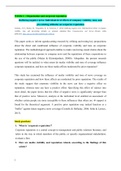2.
Which levels of influence on the news do Cornelissen et al. (2010) distinguish? Name and describe these
Respuesta: While (1) journalists have little control to the final news distributed (because usually they write for someone so to ensure their article gets published)
(2) At the news routines, editors and other supervisors are in charge of whether a story (the journalist\'s story, to be precise) gets finally published, or not. They determine what changes to make on the article, what title it should have & so on
The (3) news organisation refers to the influences on the news from within the organisation. That is, aspects such as organisational values and corporate culture shape how an article should result once it is ready to be published
The (4) external to the news organisation refers to the influences on the news organisation from outside the organisation - which may include not only environment, but also relationships and network
Lastly, (5) ideology refers to the system news media adopt to produce meanings and ideas. That is, for instance, news can have different meanings based on where they are published




